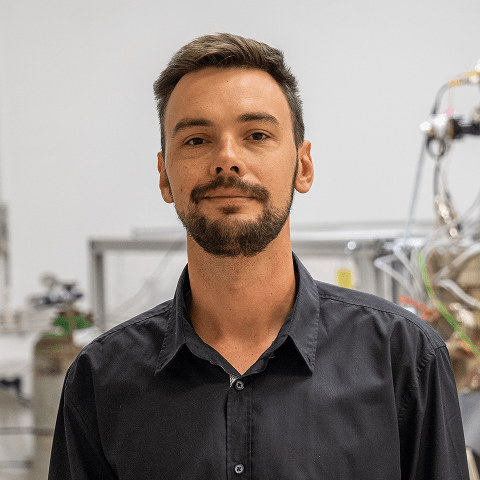Ľubomír Staňo, Mgr., PhD.
Researcher, Scientific Research Department

Bio
Researcher at CENAM since 2023. Expert in hydrogen technologies, renewable hydrogen production, alkaline water electrolysis and electrochemical cells. Extensive experience in development of measurement setups, testing protocols and evaluation of prototypes. Research focus include electrochemical water splitting, porous catalyst coatings, cell separation membranes, hydrogen detection and purity analysis.
Specialization research areas
Electrochemical cells Water electrolysis Hydrogen production Gas sensors Hydrogen detection and purity analysis Catalyst coatings Microporous structures Ion-solvating membranes Plasma treatmentEducation
2020
Dissertation thesis: Surface modification of porous polymer structures for their application as separators in alkaline water electrolysis cells
Comenius University in Bratislava, Slovakia, Faculty of Mathematics, Physics and Informatics, Department of Experimental Physics
2016
Diploma thesis: The use of hydrogen as an energy carrier in a system for energy storage from intermittent renewable powers sources
Comenius University in Bratislava, Slovakia, Faculty of Mathematics, Physics and Informatics, Department of Environmental Physics
Awards
2019
Best presentation award at: Materials for energy storage and conversion
International symposium (mESC-IS 2019), Belgrade
2019
Best presentation award at: Symposium on Application of Plasma Processes (SAPP 2019)
Štrbské Pleso
Teaching activities
Courses taught
Course Objectives
Students acquire essential knowledge of principles and properties of basic digital circuits. Gain practical experience to design and construct digital electronic devices and programing selected microprocessors and simple robotic systems.
Syllabus
Principles of DDL, DTL and TTL circuits,
Boolean functions – combinational logic networks and their optimization,
– some combination circuits (adder, multiplexer and demultiplexer)
Physical implementation of automata (sequential circuits and their applications)
– RS and D flip-flops,
(counter, shift register, three-state output, memory management (R/W))
– parallel to serial code converter and RS232 interface,
– static and dynamic RAM memories and their organization
Microprocessors.
Microprocessor structure
Arithmetic Logic Unit (ALU) Structure
Implementation of instructions and their distribution
Addressing methods,… internal and external memory
Additional devices – their connection and data transfer (data transfer, bus)
Realization of binding circuits (interface) for memories and peripheral devices
Characteristics affecting the performance of computers (clock frequency, access time, transfer capacity, size of registers…)
Programming of single-chip microcomputers in a high- and low-level programming language and the basics of robotics, types of signals, their processing and control.
Students supervision
Supervisor of bachelors students.